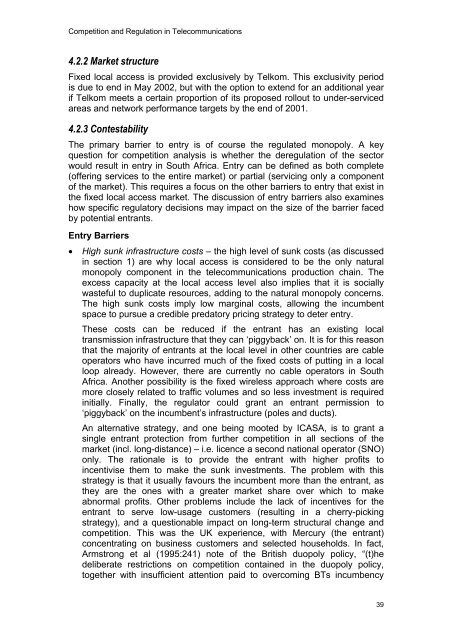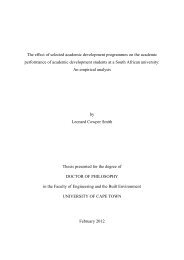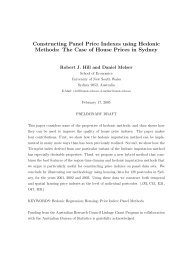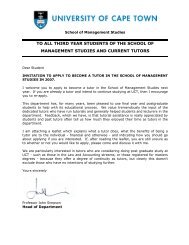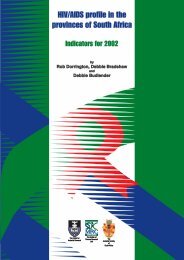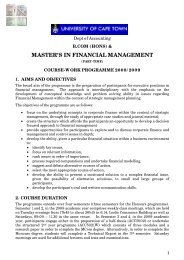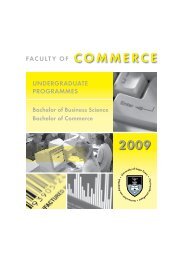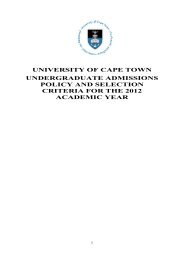Competition and Regulation in the Telecommunications Industry in ...
Competition and Regulation in the Telecommunications Industry in ...
Competition and Regulation in the Telecommunications Industry in ...
Create successful ePaper yourself
Turn your PDF publications into a flip-book with our unique Google optimized e-Paper software.
<strong>Competition</strong> <strong>and</strong> <strong>Regulation</strong> <strong>in</strong> <strong>Telecommunications</strong>4.2.2 Market structureFixed local access is provided exclusively by Telkom. This exclusivity periodis due to end <strong>in</strong> May 2002, but with <strong>the</strong> option to extend for an additional yearif Telkom meets a certa<strong>in</strong> proportion of its proposed rollout to under-servicedareas <strong>and</strong> network performance targets by <strong>the</strong> end of 2001.4.2.3 ContestabilityThe primary barrier to entry is of course <strong>the</strong> regulated monopoly. A keyquestion for competition analysis is whe<strong>the</strong>r <strong>the</strong> deregulation of <strong>the</strong> sectorwould result <strong>in</strong> entry <strong>in</strong> South Africa. Entry can be def<strong>in</strong>ed as both complete(offer<strong>in</strong>g services to <strong>the</strong> entire market) or partial (servic<strong>in</strong>g only a componentof <strong>the</strong> market). This requires a focus on <strong>the</strong> o<strong>the</strong>r barriers to entry that exist <strong>in</strong><strong>the</strong> fixed local access market. The discussion of entry barriers also exam<strong>in</strong>eshow specific regulatory decisions may impact on <strong>the</strong> size of <strong>the</strong> barrier facedby potential entrants.Entry Barriers• High sunk <strong>in</strong>frastructure costs – <strong>the</strong> high level of sunk costs (as discussed<strong>in</strong> section 1) are why local access is considered to be <strong>the</strong> only naturalmonopoly component <strong>in</strong> <strong>the</strong> telecommunications production cha<strong>in</strong>. Theexcess capacity at <strong>the</strong> local access level also implies that it is sociallywasteful to duplicate resources, add<strong>in</strong>g to <strong>the</strong> natural monopoly concerns.The high sunk costs imply low marg<strong>in</strong>al costs, allow<strong>in</strong>g <strong>the</strong> <strong>in</strong>cumbentspace to pursue a credible predatory pric<strong>in</strong>g strategy to deter entry.These costs can be reduced if <strong>the</strong> entrant has an exist<strong>in</strong>g localtransmission <strong>in</strong>frastructure that <strong>the</strong>y can ‘piggyback’ on. It is for this reasonthat <strong>the</strong> majority of entrants at <strong>the</strong> local level <strong>in</strong> o<strong>the</strong>r countries are cableoperators who have <strong>in</strong>curred much of <strong>the</strong> fixed costs of putt<strong>in</strong>g <strong>in</strong> a localloop already. However, <strong>the</strong>re are currently no cable operators <strong>in</strong> SouthAfrica. Ano<strong>the</strong>r possibility is <strong>the</strong> fixed wireless approach where costs aremore closely related to traffic volumes <strong>and</strong> so less <strong>in</strong>vestment is required<strong>in</strong>itially. F<strong>in</strong>ally, <strong>the</strong> regulator could grant an entrant permission to‘piggyback’ on <strong>the</strong> <strong>in</strong>cumbent’s <strong>in</strong>frastructure (poles <strong>and</strong> ducts).An alternative strategy, <strong>and</strong> one be<strong>in</strong>g mooted by ICASA, is to grant as<strong>in</strong>gle entrant protection from fur<strong>the</strong>r competition <strong>in</strong> all sections of <strong>the</strong>market (<strong>in</strong>cl. long-distance) – i.e. licence a second national operator (SNO)only. The rationale is to provide <strong>the</strong> entrant with higher profits to<strong>in</strong>centivise <strong>the</strong>m to make <strong>the</strong> sunk <strong>in</strong>vestments. The problem with thisstrategy is that it usually favours <strong>the</strong> <strong>in</strong>cumbent more than <strong>the</strong> entrant, as<strong>the</strong>y are <strong>the</strong> ones with a greater market share over which to makeabnormal profits. O<strong>the</strong>r problems <strong>in</strong>clude <strong>the</strong> lack of <strong>in</strong>centives for <strong>the</strong>entrant to serve low-usage customers (result<strong>in</strong>g <strong>in</strong> a cherry-pick<strong>in</strong>gstrategy), <strong>and</strong> a questionable impact on long-term structural change <strong>and</strong>competition. This was <strong>the</strong> UK experience, with Mercury (<strong>the</strong> entrant)concentrat<strong>in</strong>g on bus<strong>in</strong>ess customers <strong>and</strong> selected households. In fact,Armstrong et al (1995:241) note of <strong>the</strong> British duopoly policy, “(t)hedeliberate restrictions on competition conta<strong>in</strong>ed <strong>in</strong> <strong>the</strong> duopoly policy,toge<strong>the</strong>r with <strong>in</strong>sufficient attention paid to overcom<strong>in</strong>g BTs <strong>in</strong>cumbency39


